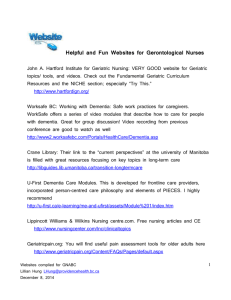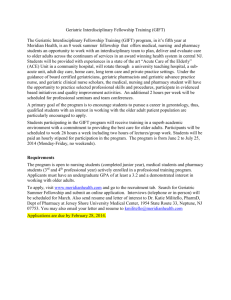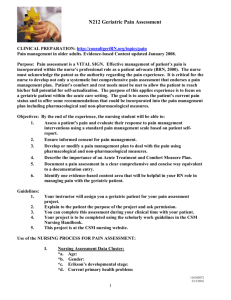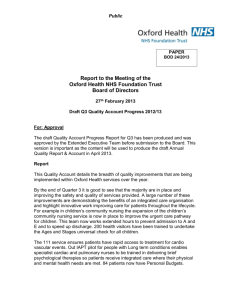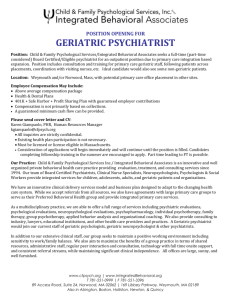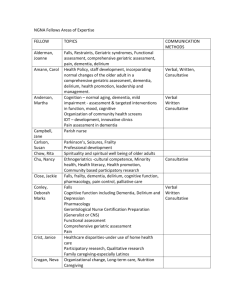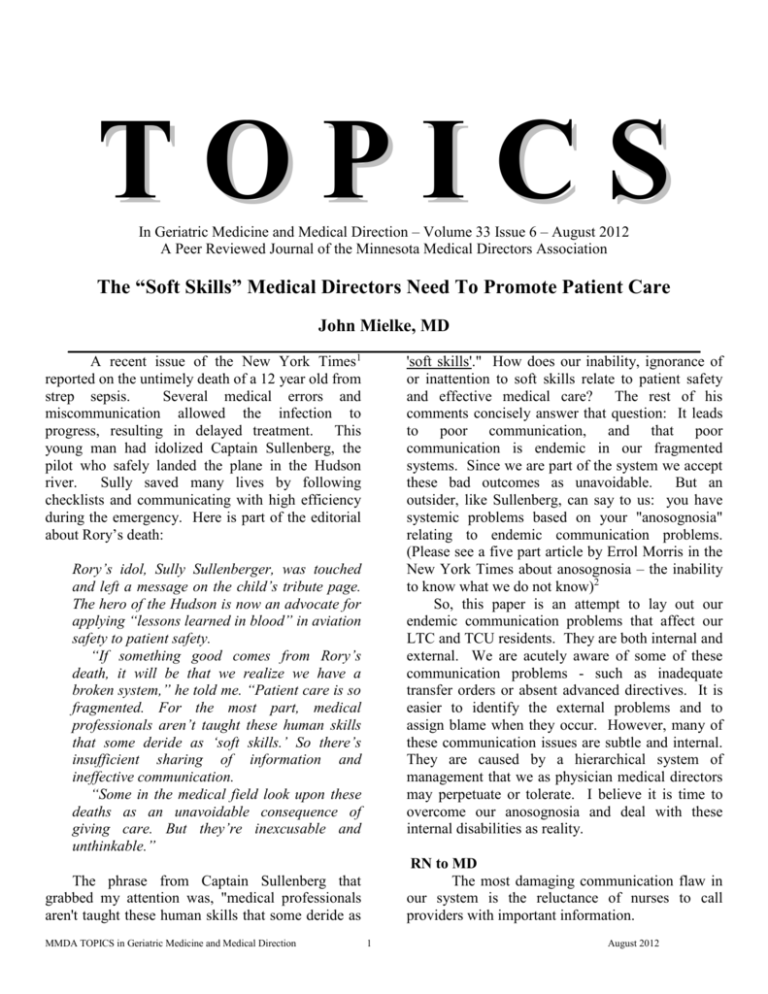
TOPICS
In Geriatric Medicine and Medical Direction – Volume 33 Issue 6 – August 2012
A Peer Reviewed Journal of the Minnesota Medical Directors Association
The “Soft Skills” Medical Directors Need To Promote Patient Care
John Mielke, MD
____________
A recent issue of the New York Times1
reported on the untimely death of a 12 year old from
strep sepsis.
Several medical errors and
miscommunication allowed the infection to
progress, resulting in delayed treatment. This
young man had idolized Captain Sullenberg, the
pilot who safely landed the plane in the Hudson
river.
Sully saved many lives by following
checklists and communicating with high efficiency
during the emergency. Here is part of the editorial
about Rory’s death:
________________________
'soft skills'." How does our inability, ignorance of
or inattention to soft skills relate to patient safety
and effective medical care? The rest of his
comments concisely answer that question: It leads
to poor communication, and that poor
communication is endemic in our fragmented
systems. Since we are part of the system we accept
these bad outcomes as unavoidable.
But an
outsider, like Sullenberg, can say to us: you have
systemic problems based on your "anosognosia"
relating to endemic communication problems.
(Please see a five part article by Errol Morris in the
New York Times about anosognosia – the inability
to know what we do not know)2
So, this paper is an attempt to lay out our
endemic communication problems that affect our
LTC and TCU residents. They are both internal and
external. We are acutely aware of some of these
communication problems - such as inadequate
transfer orders or absent advanced directives. It is
easier to identify the external problems and to
assign blame when they occur. However, many of
these communication issues are subtle and internal.
They are caused by a hierarchical system of
management that we as physician medical directors
may perpetuate or tolerate. I believe it is time to
overcome our anosognosia and deal with these
internal disabilities as reality.
Rory’s idol, Sully Sullenberger, was touched
and left a message on the child’s tribute page.
The hero of the Hudson is now an advocate for
applying “lessons learned in blood” in aviation
safety to patient safety.
“If something good comes from Rory’s
death, it will be that we realize we have a
broken system,” he told me. “Patient care is so
fragmented. For the most part, medical
professionals aren’t taught these human skills
that some deride as ‘soft skills.’ So there’s
insufficient sharing of information and
ineffective communication.
“Some in the medical field look upon these
deaths as an unavoidable consequence of
giving care. But they’re inexcusable and
unthinkable.”
RN to MD
The most damaging communication flaw in
our system is the reluctance of nurses to call
providers with important information.
The phrase from Captain Sullenberg that
grabbed my attention was, "medical professionals
aren't taught these human skills that some deride as
MMDA TOPICS in Geriatric Medicine and Medical Direction
1
August 2012
This communication flaw is a two way street – and
we are the traffic cops. Going one direction is the
nurses ability (or inability) to recognize, assess, and
communicate a change of condition in a concise,
clinically relevant manner to an anonymous
provider. In the on-coming lane is a busy, task
oriented provider who wants to get-to-the-heart-ofit and make a decision. If these communication
needs are not met for the benefit of the patient
“accidents” will happen. And when accidents
happen it is the nurse who is driving the Fiat 500
and the provider is in the H3 Hummer. It makes the
nurse reluctant to get behind the wheel again.
hard for them to envision as they live in a
hierarchical environment. It is my belief that all
human interaction occurs on a level playing field –
irrespective of status or rank. So, I encourage
dialogue about inappropriate conduct or demeaning
interactions at an appropriate time and place. This
works well when the providers are regular rounders
at a facility. It is an application of the biblical
encouragement to, “If your brother sins against you,
go to him in private and if he listens to you, you
have gained your brother.” I have witnessed nurses
do this effectively, and develop excellent working
relationships with these providers.
There is so much more to say about this topic. My
main point is that we, as medical directors, need to
pay close attention to this issue or it will be
disruptive to medical care,.
What is our role as medical directors?
We need to get the nurse a bigger vehicle
and ask the provider to slow down. Let me explain.
When a negative interaction occurs over a patient
assessment I am often called with a complaint that
the provider was “rude”. I ask the nurse what was
presented and how the interaction went. At least
50% of the time it appears that the nurse needed to
do a more robust job of data gathering, story telling,
and advocacy for the resident. So I educate,
educate, educate and use tools like the INTERACT
23 SBAR (Situation, Background, Assessment, and
Recommendation) form to help nurses package the
information in ways that deliver relevant
information quickly. I try to paint the picture of the
provider who has no information about this patient,
is often between other tasks, and not patient with
rambling and irrelevant information. It’s driver’s
training for nurses.
For medical providers I emphasize the need
to be patient (nurses are precious commodities) and
educational. This should prompt us to slow down,
ask questions, perhaps even call back after a request
for more data is gathered. One very angry surgeon
“reamed the nurse out” for dislodging a T-tube in a
patient post biliary surgery. I called to discuss our
care of the patient, and accepted his pointed
criticism of the bad outcome. Then I asked him if
maintaining the integrity of T-tubes was important
to his practice of medicine. He said, “Of course.” I
replied that maintaining the integrity of my nursing
staff was equally important to my practice of
medicine. He got the picture, and apologized for
his conduct which was passed on to the nurse.
I do also encourage the nurses to gently
confront poor interpersonal conduct directly and
one-on-one with medical providers. This is very
MMDA TOPICS in Geriatric Medicine and Medical Direction
NAR to RN
One of the fundamental building blocks of
the INTERACT 2 program (to reduce unnecessary
hospitalizations) is the STOP AND WATCH tool.
This provides nursing assistants a checklist of
symptoms to report to the nursing staff. It was
designed as an early warning system for significant
change in condition. At the AMDA meeting in
2011 Dr. Joseph Ouslander confided that the tool
did not work, that it added nothing to the overall
program. On further investigation they discovered
the reason for it’s lack of effectiveness – the nurses
did not listen to the aides’ information. In homes
where there was a culture of collaboration and
teamwork, the tool was used and effectively
incorporated into their processes.
A Case Study:
25 years ago I met with every nursing assistant
behind closed doors at an inner city nursing
home (with the permission of the
administration).
I realized that nursing
assistants were the key to successful care of the
residents, and I wanted to know what motivated
them, and what they felt they needed to do
better work. Numerous more scientific studies
have confirmed what I learned from those
dedicated nursing assistants in 1987. I told
them I could do nothing about their pay, nor
their workload. But I wanted to know why they
worked in LTC, and not the local fast food
outlet. To a person they said they valued the
personal contact and long term interaction with
2
August 2012
their residents. It was very clear that they took
pride in having their residents well cared for,
well groomed and treated with dignity. The
three things they all seemed to desire was:
better teamwork - especially with the nurses,
better training, and a pat on the back now and
then. Those values are still present in NARs I
talk to in 2012. In some ways they reflect the
three motivating factors delineated by Daniel
Pink in his recent book, Drive. The three
motivating factors for those in knowledgebased work are: Autonomy, Mastery and
Purpose.
While NARs are not highly
autonomous, they do work independently and
should be supported in this part of their job.
(Question: Do you think of NARs as
knowledge-based workers, or task-oriented
workers? This may be critical to how your
nursing facility can improve.)
Teamwork is one way to undergird their
autonomy and support their observations of
their residents. It is a serious detraction from
quality of care when nurses do not listen to or
respond to concerns of the NARs. This is a
critical piece of the INTERACT 2 process for
reducing unnecessary hospitalizations.
These traits in leadership (domineering,
hierarchical, and autocratic) should be viewed as
highly dysfunctional in the LTC and TCU
environment, yet are often rewarded for a variety of
short-sighted reasons. The complexity of care
needs, highly relational setting, and growing need
for sensitive customer service requires an “all hands
on deck” approach that only occurs with engaged
active staff, not passive task-oriented employees.
The conduct of our leaders sets the tone for
engagement or passivity.
Facility to ER
“Send them to the ER” is the default
response given by on-call providers unfamiliar with
the capabilities of the LTC facility. This is
followed by a rush to collect and photocopy a basic
minimum of information before the ambulance
arrives. It is very rare, in my experience, for MD to
MD communication to occur about the patient’s
needs, and reason for transfer.
It is beyond the scope of this paper to sort
out all the systematic barriers to communication
between LTC and the ER. It is clear that this is part
of our anosognosia about poor communication in
LTC. This can be solved on a local level, as several
medical groups in our community are proving.
They communicate proactively with the ER,
provide on site visits to transferred residents, and
even promote Acute Care for the Elderly (ACE)
units in the hospital to assure effective geriatric
care. Health Plans are beginning to participate and
see the wisdom of supporting primary care
providers who coordinate care throughout the
continuum of care.
Interact 2 has audit tools to track hospital
admissions and trips to the ER. These tools allow
medical directors to oversee this process and begin
to intervene. Just this week, I discussed a trend of
increased ER transfers related to a particular staff
nurse. This came about through the use of the
Interact 2 audit materials used by the clinical
manager of the TCU. Education and monitoring
will be put in place for this staff person.
Facility to ER is a critical communication that must
be improved at many levels.
IDT process
We give a lot of lip service to the
Interdisciplinary Team. I have sat in on IDT
meetings where the function was primarily to give
the “MDS nurse” data for billing purposes. The
various disciplines functioned in their respective
silos, inhibiting effective discharge planning.
A true IDT process in the TCU environment
is open, efficient and patient discharge focused.
This can be fostered by the attending provider or the
medical director by giving guidance and molding
the team interactions. A heavy handed physician or
NP can inhibit the interdisciplinary character of
these meetings limiting the effective transfer of
information that might be essential to avoiding
serious mistakes and facilitating successful
discharge.
In the same manner, a heavy-handed nurse
manager can limit the contribution of various
members of the team. This discourages root cause
analysis for fall intervention, leads to misdiagnosis
of behaviors, promotes passive staff responses, and
fails to capture the depth of knowledge about
individual patients that leads to better care.
MMDA TOPICS in Geriatric Medicine and Medical Direction
3
August 2012
Healing Healthcare through Positive Deviance6 by
Singhai, et. al.
Facility to Home Care/Family
If we lament the poor information at transfer
from acute care hospitals, then we must also
improve our communication with clinic based
providers and home care agencies. We will be held
accountable for post discharge rehospitalizations.
Some of these rehospitalizations occur because of
poor medication reconciliation after discharge to
home. Others occur because of our failure to
adequately educate patients on self management or
failure to connect them to necessary resources in the
community. Medical directors should be familiar
with the discharge processes and institute systems
to assure proper handoffs to the next level of care.
In Summary
While we properly value excellence in the
technical aspects of medicine, the soft skills of
communication and systems development are
critical at this stage of medical change. Medical
directors must pay attention to how communication
happens and be willing, engaged coaches for our
fellow practitioners and nursing home staff. Our
ability to transfer information quickly and
accurately with open channels of communication is
an art form that requires discipline and continuous
improvement. We should strive to develop these
skills in ourselves, and be ready to teach others to
follow our lead.
Two recent books worth reading
There are two very influential books worth
reading to promote these skills of communication
and systems development.
The Checklist
4
Manifesto by Atul Gawande is a well written book
by a practicing surgeon demonstrating how simple
checklists have saved lives in the airline industry,
construction, and in the operating room. The more
complex and fast paced our practices become, the
more important consistent reminders are for quality
of care. Checklists can fulfill that need.
There is a movement in quality
improvement called Positive Deviance. It simply
believes that in complex environments there are
some people or groups who excel at their tasks
while having the same resources and limitations as
the rest of society. By searching for these “positive
deviants” one can discover solutions to complex
problems. This has much in common with adaptive
leadership that I have written about in previous
issues of the Topics. The Power of Positive
Deviance5 by Pascale, Sternin and Sternin is an
excellent primer on the topic. There is another book
focused on health care entitled, Inviting Everyone:
MMDA TOPICS in Geriatric Medicine and Medical Direction
About the Author
John Mielke, MD, CMD is past President of the
Minnesota Medical Directors Association and
Medical Director for the Presbyterian Homes.
References
1
Dowd, Maureen. The Boy Who Wanted to Fly, , From The
New York Times: OP-ED COLUMNIST: The Boy Who
Wanted to Fly http://nyti.ms/NrUxLJ. Accessed July 16, 2012
2
Morris, Errol. The Agnostics Dilemma, The New York
Times http://opinionator.blogs.nytimes.com/2010/06/20/theanosognosics-dilemma. Accessed July 23, 2012
3
Interact
2
Tools
http://www.interact2.net/tools.html.
Accessed July 23, 2012
4
Atul Gawande. The Checklist Manifesto: How to Get Things
Right. Metropolitan Books 2009
5
Pascale, Richard, Sternin, Jerry, and Sternin, Monique. The
Power of Positive Deviance: How Unlikely Innovators Solve
the World’s Toughest Problems. Harvard Business Press 2010
6
Singhal Arvind, Prucia Buscell, and Curt Lindberg . Inviting
Everyone: Healing Healthcare Through Positive Deviance.
PlexusPress, 2010
4
August 2012
deliver optimal evidence-based care for these
challenging problems.
Our training program
includes brief lectures covering the spectrum of
assessment,
non-drug
management,
and
antipsychotic use. It also includes evidence-based
reviews on non-drug management, delirium, and
pharmacologic management of problem behaviors
and psychosis. Finally, we have developed a fact
sheet for patient families to encourage shared
decision making on antipsychotic use, written using
health literacy principles. This was developed in
collaboration with Health Literacy Iowa, with
feedback from the New Readers of Iowa and an
Alzheimer’s Association caregiver support group.
The website includes links and brief videos for
patient families.
With your help, we hope that our training
and resources will have a positive impact on the
care of people with dementia. We encourage you to
visit our website and create a login to learn more
about the available resources. We thank the
Agency for Healthcare Research and Quality, our
stakeholders and collaborators, and all who
provided feedback on the products for making this
possible.
The “Improving Antipsychotic Appropriateness
in Dementia Patients” Clinical Tools and
Training Program
By: Ryan Carnahan Pharm.D., M.S., BCPP and
Paul Mulhausen, MD, MHS
Iowa Geriatric Education Center
The Iowa Geriatric Education Center is
pleased to announce a new program, “IA-ADAPT:
Improving Antipsychotic Appropriateness in
Dementia Patients,” produced in collaboration with
the Health Effectiveness Research Center, Health
Literacy Iowa, Telligen, PMC Studios, and
stakeholders, and supported by the Agency for
Healthcare Research and Quality. This program
includes clinical decision aids and training to
improve the management of problem behaviors and
psychosis in dementia. Free continuing education
credit and laminated pocket guides are available for
providers in Iowa. An app containing the pocket
guides is available for Android devices, and a web
app for iPhones and iPads will be added to the
website in the near future. The program can be
found at: https://www.healthcare.uiowa.edu/igec/iaadapt/.
On March 29th, 2012, the Centers for
Medicare and Medicaid Services (CMS) announced
a major initiative to improve behavioral health and
reduce antipsychotic use in nursing home residents,
underscoring the importance of this topic. Evidence
suggests that antipsychotics are often used
inappropriately in people with dementia, and can
contribute to adverse events including stroke and
death. Approximately 22% of antipsychotics in
nursing homes are used inappropriately according to
CMS standards, suggesting room for improvement.
Proper management of behaviors and psychosis
starts with assessment and management of possible
contributing causes, including pain, uncontrolled
medical disorders, delirium, and environmental
factors. Non-drug methods to prevent and manage
behaviors can be effective for many patients, but
providers are often undertrained in their use. If an
antipsychotic is necessary, it is essential to
understand how to select, dose, and monitor its
effectiveness and side effects based on patient
comorbidities and symptoms.
With the help of stakeholder organizations
including IHCA, and healthcare providers who care
for people with dementia, we have developed
pocket guides and other resources to help providers
MMDA TOPICS in Geriatric Medicine and Medical Direction
5
August 2012
President's Letter
Our fall conference is fully planned and the agenda looks great. Please encourage your colleagues
to attend. Remind them that even if they are not Medical Directors the agenda is rich in clinical as well as
leadership opportunities for anyone providing geriatric care in our community.
The Thursday afternoon preconference has been renamed to honor Dr. James Pattee. Our speaker is
Dr. Warren Hoffman who worked with Dr. Pattee to design the Medical Director Curriculum and
Certification Course. It is an honor to have such a close associate of Dr Pattee agree to further our
leadership education. He is an author, presenter, coach, and assessment specialist, and a leading authority
in helping organizations deal with learning disabilities, paradigm shifts, and critical tipping points. His
most recent book is Learning Disabilities in Organizations. He has served as assessment specialist and
coach for Personnel Decisions International, director of leadership development and training for a Dayton
Hudson operating company, executive director of the North Central Career Development Center, adjunct
faculty, University of Minnesota School of Medicine, and currently on the core faculty of the Physician
Leadership College, University of St. Thomas; he began his professional life as a Presbyterian Pastor in
Minnesota and Illinois.
Our keynote Friday will be a national speaker, Ms. Molly Cox. Her perspective and experience on
what it takes to inspire people to outstanding results in a range of businesses from healthcare to
technology, real estate, hospitality and retail has distinguished her as a highly sought after speaker. Her
expertise in writing and performing comedy with a message has been used in short film production and
live stage performances.
Ms. Cox blends her business, education and improvisation background to connect body, mind and
spirit to show people how to become more effective professionally and personally and to help people to
live a more joyful life. Her personal experience with caregiver stress as the caregiver to her mother, who
had cancer, and the primary caregiver to her father, who suffered from Alzheimer's disease, makes her
message particularly meaningful for geriatric practitioners.
Christine Duncan MD
President,
Minnesota Medical Directors Association
POCKET CODER FOR LONG-TERM CARE AVAILABLE
A laminated pocket-sized guide for coding diagnoses commonly encountered by
LTC providers is now available free of charge to MMDA members.
Contact David E. Pautz, MD, FACP at 651-662-1863 or 1-888-878-0139 or
David_E_Pautz@bluecrossmn.com with the number of guides needed.
MMDA TOPICS in Geriatric Medicine and Medical Direction
6
August 2012
SAVE THE DATE
Minnesota Medical Directors Association
Transitions in Geriatrics
Conference
October 25-26, 2012
Minneapolis Marriott Southwest
Thursday October 25, 2012
2:00- 5:30 p.m.
Leadership Preconference
6:30 p.m.
Fall Conference Kick Off and MMDA Annual Business Meeting
Friday, October 26, 2012
8:00 a.m. -5:00 p.m.
Topics Include:
Caregiver Stress
Antibiotic Stewardship Talk
Insomnia as We Age
Prevention, Treatment and Healing of Wounds
Why We Become Professionals in Long Term Care
Billing and Coding
Pay for Performance (PIP) Program Update
Pressure Ulcers
Medical Home in the Nursing Home
Atypical Antipsychotic Use in Dementia
Brochures available end of August. Questions, please contact Rosemary at rlobeck@mnmeddir.org or
(952) 929-9398
Sponsored by the Minnesota Medical Directors Association and the Minnesota Geriatrics Society
MMDA TOPICS in Geriatric Medicine and Medical Direction
7
August 2012
Minnesota Medical Directors Association
P. O. Box 24475
Minneapolis, MN 55424
Phone:
952-929-9398
Fax: 952-929-4363
Website:www.minnesotageriatrics.org
Executive Director: Rosemary Lobeck
Editor: C. Dwight Townes, M.D.
E-mail: rlobeck@mnmeddir.org
Topics in Geriatric Medicine and
Medical Direction is produced and
Published bimonthly by the Minnesota
Medical Directors Association.
Inside
The “Soft Skills” Medical Directors Need To
Promote Patient Care
Page 1
Topics in Geriatric Medicine and Medical Direction, the
peer reviewed bimonthly publication of the Minnesota
Medical Directors Association, is committed to publishing
quality manuscripts representing scholarly inquiry into all
areas of geriatrics and long term care medical direction
and practice. We encourage submissions of geriatric and
long term care research, best practices, reviews of
literature and essays.
The “Improving Antipsychotic Appropriateness in Dementia Patients” Clinical Tools and
Training Program
Page 5
President’s Letter
Page 6
MMDA Fall Conference
Page 7
Manuscripts should be emailed to rlobeck@mnmeddir.org
and cdwighttownes@hotmail.com. The first page should
include the title and a 50 to 60 word abstract. Manuscripts
should range around 1800 to 3000 words.
Review Policy: Manuscripts will be reviewed by at least
two members of the review board whose evaluations will
provide a basis for the publication decision. We are
committed to a rapid review process.
All rights reserved.
Copyright Minnesota Medical
Directors Association. Topics may be copied only with
prior permission. Contact MMDA at 952-929-9398.
MMDA TOPICS in Geriatric Medicine and Medical Direction
8
August 2012

